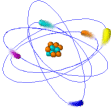
Fractal Research/Products
Printing 3D structures of living tissue

 |
Fractal Research/Products Printing 3D structures of living tissue |
 |
| Charleston scientists
use desktop printers to produce three-dimensional structures of living
tissue Charleston Post and Courier, January 1, 2003 By Lynne LangleyCharleston and Clemson scientists are using modified desktop printers to produce three-dimensional structures of living tissue, seen as a tiny first step toward printing entire organs and personalizing medicine. "This could have the same kind of impact that Gutenberg's press did," said Dr. Vladimir Mironov, director of the Shared Tissue Engineering Laboratory at Medical University of South Carolina. "It sounds like science fiction, but it's not," said Thomas Boland, an assistant bioengineering professor at Clemson University. Ink is washed from printer cartridges, which are then filled with clumps of living cells and what's called a smart gel. A standard printer nozzle prints alternate layers of cells and the biodegradable gel, which serves as paper or structure. Layers are so thin that the cells come into contact and fuse into bits of tissue, creating a tube or other three-dimensional form not seen in single layers of cells in a petri dish. Mironov and Boland are the first to build 3-D tissue structures, and this is the first time scientists have printed living tissue, Boland said. Other labs have printed an array of DNA and proteins, he said. Once the tissue-engineered structure is complete, the smart gel is cooled a bit, turns to liquid and is washed away to leave just live cells behind.Mironov and Boland are the lead authors of a paper that will be printed in April's British journal Trends in Biotechnology. The findings are drawing attention this week on both sides of the Atlantic. "I was very surprised at the attention," said Mironov, MUSC research assistant professor of cell biology and anatomy. People seem intrigued that the tissue printing involves a common jet printer, he said. "It's only the beginning," Mironov said of a technique he described as very fast and inexpensive. Printing a whole organ will demand a great deal more work, he said. While tissue the depth of a kidney already could be grown in a couple of hours, an organ requires several types of tissues and a blood system to support it. Mironov is working on printing tubes, which could lead to blood vessels. As in printing multiple colors in a picture, different types of cells could be placed in ink cartridges and make it possible to create organs with many cell types, Boland said. "If everything works as we hope it will, this could revolutionize medical care," he said. "Every hospital would have a printer with the components to make a fully functioning organ." It could take 10 to 15 years to bring science and technology to that point, the scientists said. Mironov pointed to the long transplant waiting list. "If we can print organs in two hours from cells from a patient, we can help solve that situation," he said. Using a patient's own cells would avoid rejection and the use of anti-rejection drugs and would mean a patient could receive a new organ before becoming more seriously ill and debilitated. In the next 10 years, before organs are printed, Mironov foresees use of printed tissue in personalized medicine, which companies are beginning to offer doctors and patients. For instance, a Pittsburgh firm accepts tumor cells and, for $500, tests promising cancer-fighting drugs to see which fight the tumor best. The oncologist can then use the most effective treatment. These days, tests are run on a two-dimensional slide of cells in a petri dish, whereas three-dimensional structures often behave very differently, Mironov said. Printed tissue structures will revolutionize drug research, he predicted, by speeding up testing, saving research animals and making drug development less expensive. Potential medicines could be tested on human cell structures instead of animals, which would give results much closer to reality. Mironov and his colleagues, including MUSC cell biology and anatomy department Chairman Dr. Roger Markwald and Clemson researchers, want to perfect the technology; companies could then develop tissue printing for human use, Mironov said. Clemson is modifying printer feed systems and reprogramming computer software to control the viscosity, electrical resistances and temperature of printing fluids in order to print live cells. So far, Mironov has used hamster ovary cells because they
are easy to observe as they move, but he said other living cells also
could be printed into 3-D structures. "I believe our technology
can be combined with stem cells," for example, in growing organs,
Mironov said. He does not foresee tissue printing replacing stem cell
use and research but noted that stem cells can be harvested from adult
fat cells and not just from embryos. |